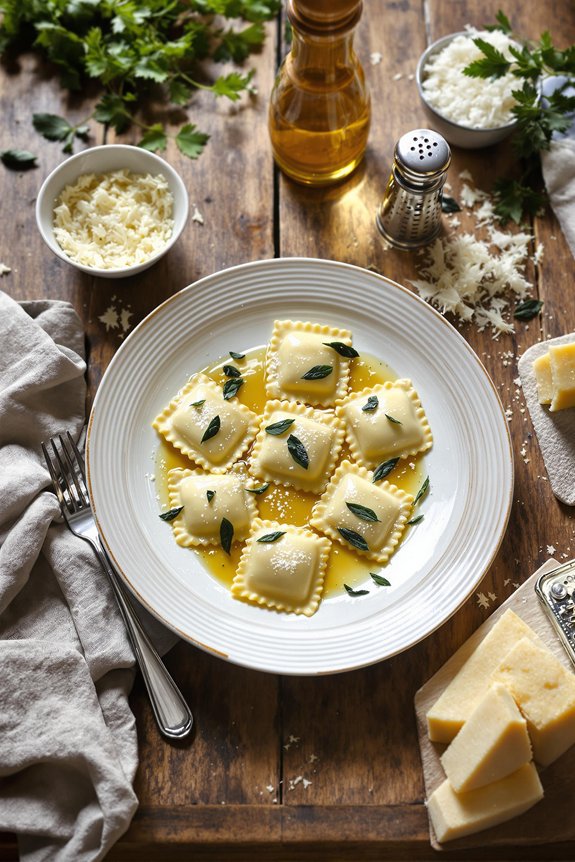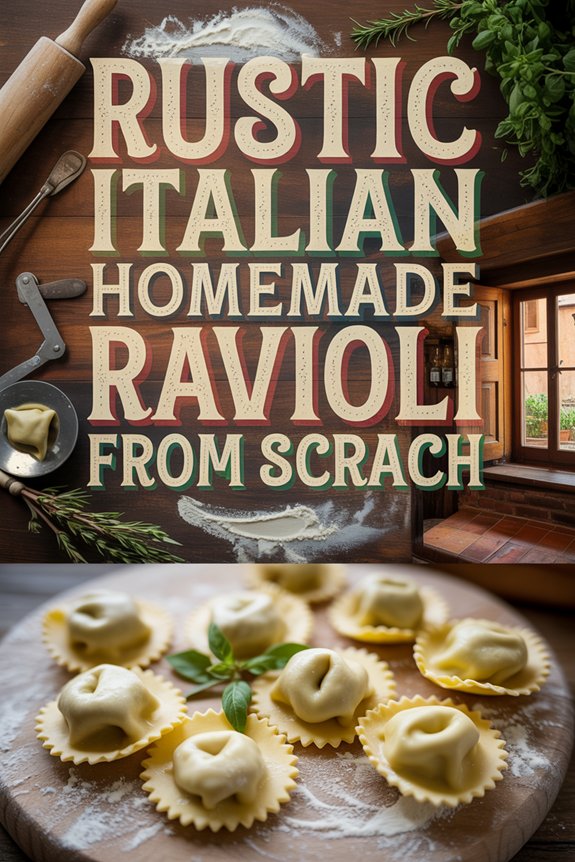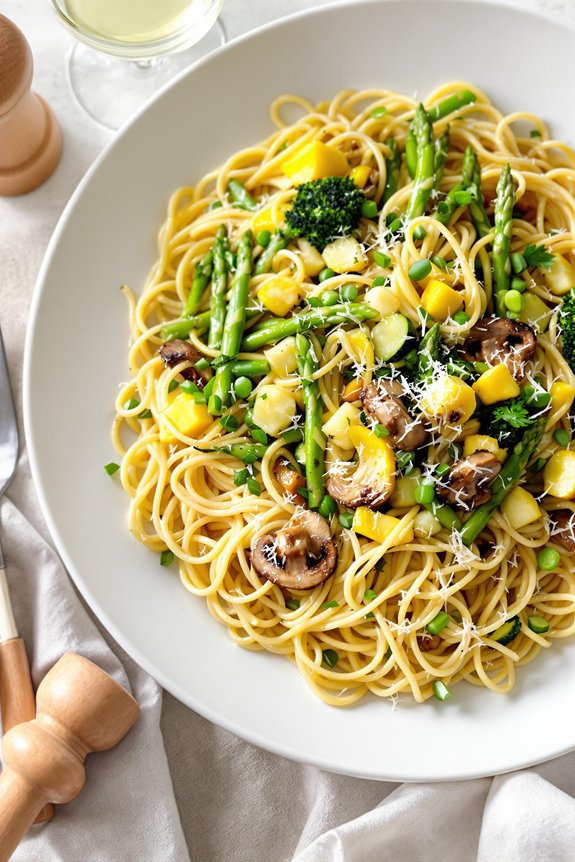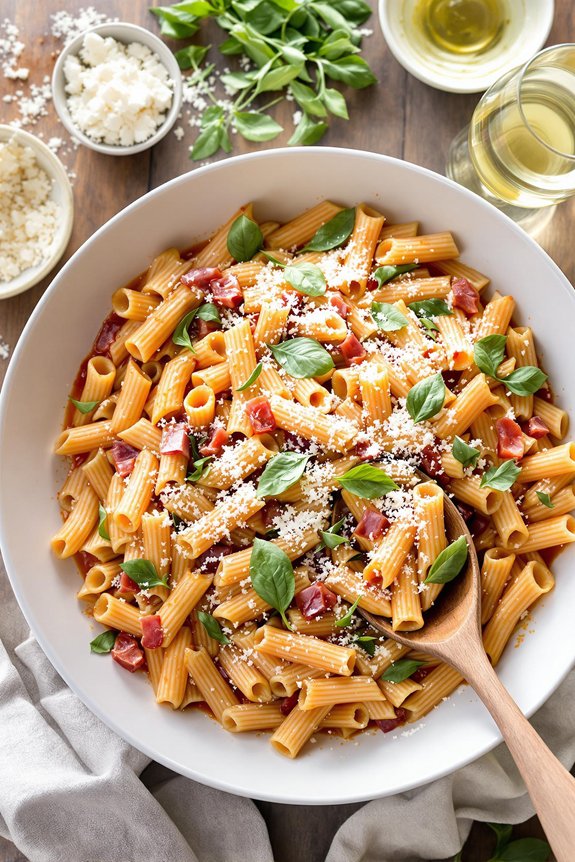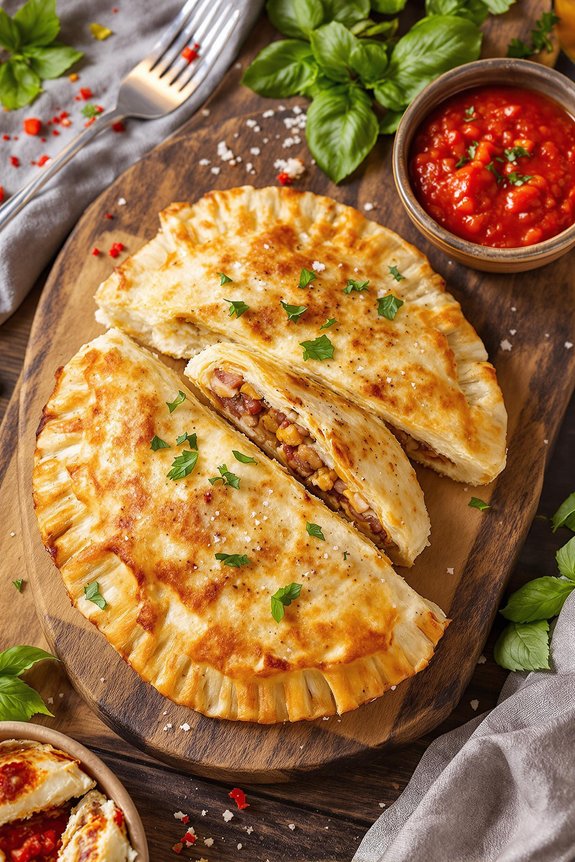Why You’ll Love these Rustic Italian Ravioli
Every single bite of these homemade ravioli delivers that authentic Italian comfort you simply can’t find in store-bought versions.
The pillowy pockets, filled with a perfect blend of ricotta, mozzarella, and parmesan, practically melt in your mouth.
I’m obsessed with how the fresh pasta yields that perfect al dente texture—slightly firm but tender enough to showcase the creamy filling inside.
Can you imagine pulling these little pouches of joy from boiling water, knowing you crafted them by hand?
Plus, there’s something deeply satisfying about rolling dough to that precise 1/16-inch thickness.
Pure pasta perfection.
What Ingredients are in Rustic Italian Ravioli?
The magic of homemade ravioli lies in its simple, quality ingredients. For this rustic Italian favorite, we’re combining traditional pasta dough elements with a rich, cheesy filling that brings all those comforting flavors you expect from authentic Italian cuisine.
The beauty of making ravioli from scratch is that you can actually taste each component—the tender egg dough, the creamy cheese mixture, all coming together in perfect harmony.
For the pasta dough:
- 3¾ cups flour
- 5 eggs
- 3 tablespoons olive oil
- 1 pinch salt
For the cheese filling:
- 2 cups fat-free ricotta cheese
- 1 cup part-skim mozzarella cheese
- 3 eggs
- ½ cup lowfat Parmesan cheese
- ¼ cup parsley
When shopping for these ingredients, quality really matters. Could you use pre-shredded cheese? Sure, but freshly grated Parmesan and high-quality mozzarella will melt more beautifully into the ricotta.
And speaking of eggs, they’re doing double duty here—creating structure in both the dough and filling, so farm-fresh is worth the splurge if you can manage it.
The blend of three different cheeses creates that perfect balance of creaminess and flavor, while the parsley adds a fresh, herbaceous note that brightens the entire dish.
How to Make these Rustic Italian Ravioli
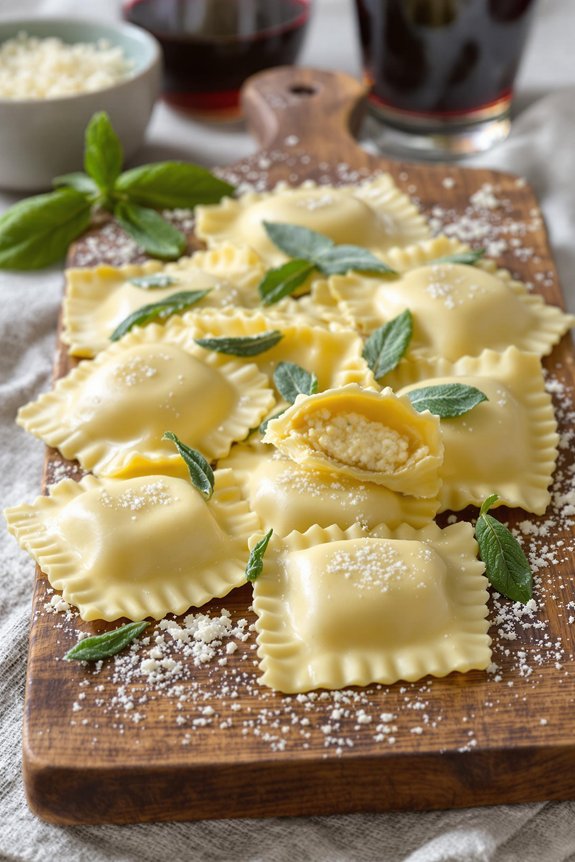
The magic happens when you start bringing your ravioli together. Begin by making the dough, combining 3¾ cups flour, 5 eggs, 3 tablespoons olive oil, and a pinch of salt. This isn’t a quick mix-and-go situation—you’ll need to knead this dough for a full 10 to 15 minutes until it becomes smooth and elastic. Trust me, your arm might get tired, but this step develops the gluten that gives your pasta that perfect chewy texture.
Once your dough is ready, it needs to rest for about an hour, covered with a kitchen towel. This resting period is non-negotiable; it allows the gluten to relax and makes the dough much easier to roll out later.
After your dough has rested, it’s time for the fun part. Roll the dough out to about 1/16th inch thickness—think paper-thin but not transparent. You can use a pasta machine if you have one (aren’t those people with pasta machines living their best lives?), or a rolling pin works perfectly fine too.
Now, prepare your filling by mixing 2 cups fat-free ricotta, 1 cup part-skim mozzarella, 3 eggs, ½ cup lowfat Parmesan, and ¼ cup parsley until well combined. Pipe or spoon small dollops of this cheese mixture onto half of your dough, leaving enough space between each dollop. Carefully place another layer of dough on top, and gently press around each mound of filling to seal, making sure to remove any air bubbles—they’re the enemy of good ravioli.
Cut your ravioli using cookie cutters or a ravioli cutter wheel, and voilà, you’ve got homemade pasta ready for cooking.
The final step is cooking these little pockets of joy. Bring a large pot of salted water to a boil—and yes, the water should taste like the sea. For the best cooking experience, consider using a premium Italian cookware set that distributes heat evenly and prevents your delicate ravioli from sticking to the pot. Gently drop your ravioli in and cook for just 3 to 4 minutes. Unlike dried pasta, fresh ravioli cooks incredibly fast, and you’ll know they’re done when they float to the surface.
Drain carefully, then toss with your favorite sauce. Traditional tomato sauce is always a winner, but a simple brown butter and sage sauce might be the perfect way to showcase your handmade creation.
Who knew something so impressive could come from your very own kitchen? The rustic, slightly imperfect shape of each ravioli is what makes them truly special—proof they were made with care rather than machinery.
Rustic Italian Ravioli Substitutions and Variations
Now that you’ve mastered the basic ravioli technique, let’s explore how to make this recipe your own.
The filling is where you can really get creative. Try swapping ricotta for mascarpone or goat cheese for a tangy twist. Not a fan of mozzarella? Fontina or provolone work beautifully too.
For herb lovers, replace parsley with basil, sage, or thyme. You can add depth with roasted garlic, sautéed mushrooms, or wilted spinach.
Vegetarians rejoice—the possibilities are endless! Meat enthusiasts might consider adding ground sausage or prosciutto.
Can’t have eggs? Aquafaba or flax eggs make decent substitutes in the dough.
What to Serve with Rustic Italian Ravioli
While your homemade ravioli can certainly stand alone as a showstopper, finding the perfect accompaniments will elevate your Italian feast to restaurant-worthy status.
I’m a firm believer in simple, complementary sides that don’t overshadow your pasta masterpiece. A peppery arugula salad with lemon vinaigrette cuts through the richness beautifully. Crusty garlic bread? Non-negotiable for sauce-sopping duties.
For vegetables, I recommend roasted asparagus or broccolini with a touch of red pepper flakes.
Wine pairing matters too—a medium-bodied Sangiovese or Chianti balances those cheesy ricotta and mozzarella flavors without overwhelming them.
Final Thoughts
Making homemade ravioli transforms an ordinary dinner into something truly special, even though it requires patience and practice.
There’s something magical about crafting those little pillows of pasta with your own hands, knowing exactly what goes into them.
Remember, your first batch mightn’t look perfect—mine certainly didn’t. But that’s part of the charm.
The rustic, slightly imperfect edges tell a story of love and care that store-bought varieties simply can’t match.
Trust me, once you’ve mastered this recipe, you’ll find yourself returning to it whenever you want to impress someone, including yourself.

